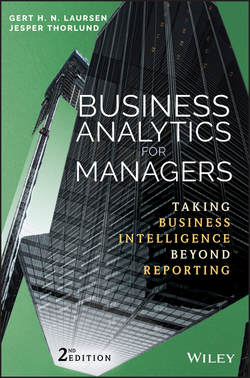Читать книгу Business Analytics for Managers - Thorlund Jesper - Страница 4
Foreword
ОглавлениеThis book provides more fuel for this era of strategic and unified views of business analytics for value creation. In the same vein as Competing on Analytics and Analytics at Work, Business Analytics for Managers: Business Intelligence beyond Reporting adds another interesting and worthwhile perspective on the topic. In times of rapid change and growing complexity, rapid learning becomes more valuable. This book provides the strategic view on what's required to enable rapid learning and ultimately value creation.
Making decisions using huge, noisy, messy data requires business analytics. It is important to have a true appreciation of and advocacy for the analytical perspective on the whole of business analytics – on data (a strategic asset), on methods and processes (including refinement and optimization), and on people (the diverse skills it takes to formulate and execute on a well‐thought‐through strategy).
It starts with an analytical view of data: What is being measured, and is it what matters? Measurement (data generation and collection) is itself a process – the process of manufacturing an asset. When data is viewed this way, the analytical concepts of quality improvement and process optimization can be applied. The authors essentially ask, “What are you doing with your data? How are people in your organization armed to make better decisions using the data, processes, and analytical methods available?”
Business analytics, as portrayed by these analytical thinkers, is about value creation. Value creation can take different forms through greater efficiency or greater effectiveness. Better decisions to reduce costs, reveal opportunity, and improve the allocation of resources can all create value. The authors provide valuable business analytics foundational concepts to help organizations create value in a sustainable and scalable way.
Why business analytics? Even though some have tried to expand the definition of the relatively aged term business intelligence (BI), there is no real consistency, so a new term reflecting a new focus is warranted. Further, through promotion of a process view, we break out of some of the silothink and see the importance of closing the loop – on data (to monitor data quality and measure what matters), on process (to continuously learn and improve), and on performance (to make the best decisions, enable the best actions, and measure impact). How many organizations continue producing text‐heavy, tabular reporting on old and perhaps out‐of‐date metrics that few take the time to consume? How old are some of the processes driving key decisions in organizations? What opportunity costs are you incurring, and how could you be creating more value?
This book provides a synthesized view of analysis, traditional BI, and performance management, all of which are connected and need to be orchestrated strategically for maximum impact. The chapter advocating a shared strategic resource – a competency center or center of excellence – is an excellent way to drive best practices and create more value, making the case for treating data as a strategic asset and investing in the appropriate analytic infrastructure to maximize value.
Wherever you may be on your business analytics journey, you will find worthwhile thinking, shared expertise, and solid practical advice in this book to help you create more value in a sustainable and scalable way. The book is not just about analytics as a step in any given business process, but about the analytical perspective on any process that is key to understanding what it takes to drive continuous learning and improvement.
Anne Milley,
Senior Director of Analytic Strategy
SAS Institute
